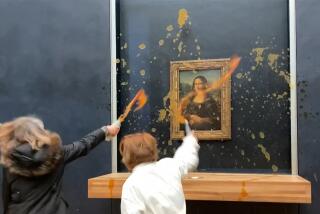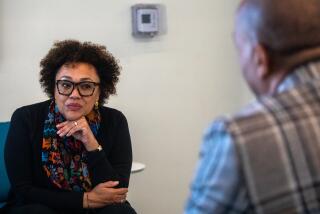Still Boiling
- Share via
Christopher Knight’s discomfort with the involvement advocated by some arts organizations’ response to events triggered by Sept. 11 is another instance of his inability to consider ideas that do not conform to his narrow, traditional and even elitist viewpoint (“What Exactly Can Art Heal?,” Nov. 4). Of course, no piece of art ever “cured” a serious medical or psychological problem; however, if one need be so literal, it can be part of a beneficial environment that promotes healing.
Knight might discover something different regarding who remembers anything from the Arts Recovery Program of the Cultural Affairs Department in 1992 if he bothered to speak with anyone who participated. The program was designed to deliver funds to artists who were directly affected by the earthquake. Does Knight really think that this is a waste of civic funds? Or are they artists he would not have selected for support?
Knight belittles any program or type of art that does not fit his rarefied tastes, is unwilling to accept anything that strays from what he might have learned in school 25 years ago, and has consistently confused process with art.
His strident complaints about politicians, civic programs and large institutions do not serve any real purpose, and he misses or glosses over the larger implications of economic stimulation, discourse among diverse social groups, and the continued support of artists and artistic activity these means bring about.
Knight has consistently demonstrated an inability to understand or make connections with the diversity of people and arts that are present in Los Angeles. The education, help or encouragement planned for a mass audience is from a part of the same perspective that is--or can be (ahem)--served by writing.
ROELLA HSIEH LOUIE
Deputy director
Workforce Development Division
Community Development Department
City of Los Angeles
*
Knight dismisses the value of building community and sharing our fears through the arts as fiction. He sees the arts instead as “amoral.” Why, then, are the arts increasingly incorporated into the design of hospitals and patient care? Numerous studies have shown the value of the arts in helping reduce patient stays, improving patient and staff morale, and enhancing communication of information.
They provide patients with opportunities of choice and accomplishment, key to rebuilding self-esteem and a positive attitude, critical components of healing.
In a sense, our nation is facing many of the same challenges as a person who has learned that he or she has cancer. A critical first step is regaining control of your life and expressing your emotions.
The arts are crucial at a time when our nation’s spirits need to be uplifted, when people need to come together and rekindle their deepest shared values. The arts’ moral value is, in fact, their most needed value at this moment in time.
NAJ WIKOFF
President Society for the Arts in Health Care
Washington, D.C.
*
Knight is cynical, selfish and wrongheaded when he maintains that art as metaphysical balm is an anachronism.
Programs aiming to heal civic woes with art may be inadequate. Does this fact prove that the need for spiritual healing from art is absent or inappropriate? Are leaders who extol the healing power of art really trying to numb the public into forgetting the graver issues of the day? Even if they are, the need to understand political realities and the need for solace from art are hardly mutually exclusive.
Knight cites art institutions’ “insupportable claims about the efficacy of therapeutic culture.” In fact, his entire piece is based on insupportable claims to the contrary. Has art truly evolved to the point where any spiritual benefit is suffocating, or has art criticism devolved into the total regulation of public sensibility?
DAVID HOWARD
Clarinetist, L.A. Philharmonic
Los Angeles
*
Kudos to Knight for having the courage to debunk the art-as-therapy theory. By extension, he could have helped us understand the current rage by also debunking the Mozart myth. Art, artists and art educators have for as long as I can remember been responsible for Hitler as a frustrated artist, poor academic test scores, the rising cost of education in public schools, criminal behavior and now healing America with visual images other than those seen on TV. I suspect next we should now try to discover Osama bin Laden’s favorite color to help him straighten out his life. If the art gets better, will the ills of the world also improve, and what happens if we stop making art, good or bad?
JOSEPH A. GATTO
Dean, visual arts department
L.A. County High School for the Arts
Los Angeles
More to Read
The biggest entertainment stories
Get our big stories about Hollywood, film, television, music, arts, culture and more right in your inbox as soon as they publish.
You may occasionally receive promotional content from the Los Angeles Times.










